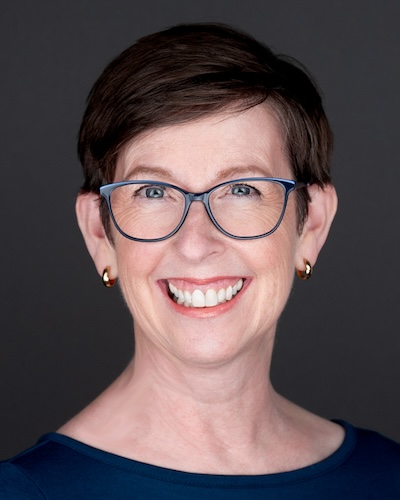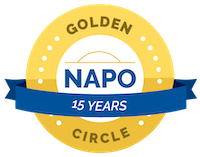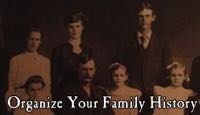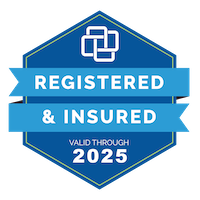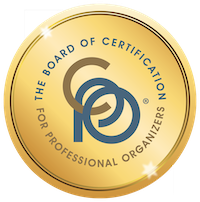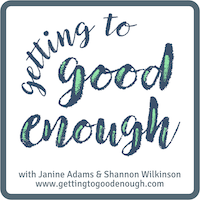You're reading a top organizing blog

Over the years, I’ve been pleased to see that this blog, which I’ve been writing for 19 (!) years, has consistently been included in Feedspot’s ranking of the Best Organizing Blogs and Websites and Best Decluttering Blogs and Websites. Feedspot updates their lists yearly and I’ve been slowly creeping my way up the rankings.
This year, the Peace of Mind Organizing blog is #4 on both lists!
I know this isn’t a hugely meaningful accolade but I love the acknowledgment of my consistent effort to blog regularly. My back-of-the-napkin estimate is that I’ve published 1685 blog posts since I started this blog in 2006. I feel fortunate to have the opportunity to express my thoughts I such a safe place.
To all my readers: Thank you!
20th anniversary reflection: You don't have to do it alone
As I celebrate 20 years of Peace of Mind Organizing® this year, I keep coming back to this fundamental truth I wrote about in 2010. This message feels even more relevant today—both for the clients we serve and for the team approach that has become the heart of the business. Sometimes the most important lessons are worth repeating and that’s what I’ll be doing each month as part of this anniversary series.
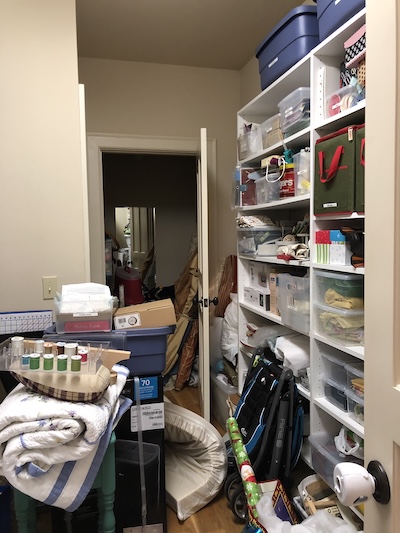
Before I became an organizer, I struggled with creating systems for getting my messy self to stay organized. I bought, read and learned from many books on organizing. (My friend, the Mississippi garden writer Felder Rushing once looked at my bookshelf and said with his distinctive Southern drawl, “Janine, you’d have a lot less clutter if you’d just get rid of these books on clutter.”)
When I decided to become a professional organizer, I started taking classes so I could bring expertise to the table. I learned, however, that I bring more than expertise to my client sessions. I bring support. If all you need is expertise, then reading about a topic might be sufficient.
But when it comes to organizing and dealing with clutter it can be really hard to get started on your own. That’s where finding a buddy or a professional to help can make a big difference.
By hiring a professional organizer you:
- Make a time commitment to working on your organizing goals
- Make a financial commitment, which can be very motivating
- Become accountable to someone
- Benefit from the organizer’s expertise
- Have some fun with it, because you have company
If your clutter or organizing challenges feel like more than you can handle alone, don’t be afraid to reach out for help. If you can afford one-on-one help with an organizer (or the help of an organizing team), believe me it will be worth the investment. If you can’t, look around the internet…there are some great lower cost options that can still give you the support you need.
Using self care to prepare for decluttering

In May, I republished one of my favorite blog posts, Self-care, which is about the importance of taking time for self care even if you feel like you should be working on decluttering and organizing your home. I suggested that you could use self-care activities as a reward for making some progress on your organizing projects.
I received a lovely email response from reader Joan Paul who suggested that self care could be an important way to prepare for the stress of a decluttering and/or organizing session.
She wrote:
Maybe filling our tank with self-care before starting a decluttering project is just as key or even more important than using it as a reward. Maybe if we are properly nurtured by our self-care we won’t be so paralyzed and overwhelmed about decluttering!
I love that way of thinking and to be honest I hadn’t thought of that way before.
Taking care of yourself is one of the most important things you can do to live a happy and healthy life. If clutter has gotten out of hand and you have difficulty addressing it, then incorporating some self care into the process (whether that’s before or after the decluttering session, or both!) can only benefit you.
Sometimes self care looks like calling in an organizer or an organizing team to jump start your activities or get it done swiftly. (I’m a huge believer in asking for help and wouldn’t have been able to survive last year’s move if I hadn’t hired organizers to get me packed and unpacked.) If you live in St. Louis, we’re happy to help you. If you live elsewhere, you can find an organizer near you at NAPO.net.
Photo by Maddi Bazzocco on Unsplash
Worth repeating: Daily exercise for the win!
I wrote this post three years ago. Since then I’ve started working with a trainer each week, which is great. But I still find it hard to get excited to exercise between training sessions. Reading my brother’s simple approach (especially the concept of any exercise being better than no exercise) is inspiring me to get busy and exercise this morning!
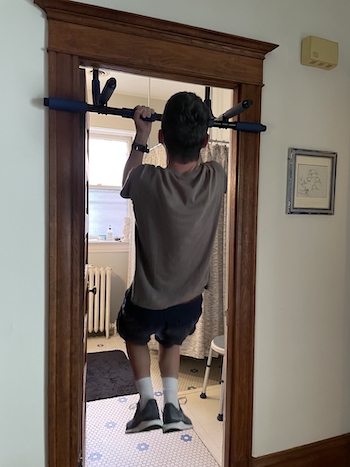
My brother, Larry, is visiting me right now. He lives in Australia, so I don’t get to see him often. Our father died last month in Walla Walla, Washington, and Larry made an emergency trip to the U.S. After the memorial service, he came back to St. Louis with my husband and me.
We’re having a great time hanging out and catching up. And we’re even learning a thing or two from one another. One thing that Larry’s really impressed me with his daily habit of doing pull ups. Larry is a slender, strong 63-year-old man. He’s genetically inclined to being slender but he also has muscles. And now I know why.
Every day, Larry does ten pull ups.
He tells me that he started his pull-up routine in 1995. He started with only four, which was very easy for him to do. He slowly increased the number and now he’s up to ten. Along the way, he’s created a few rules for himself. If he can’t do all ten because he doesn’t feel strong enough, he lets himself take a break. He can make up the difference a little later or, barring that, he’ll make up the difference the next day.
When I asked Larry about his daily exercise habit and how he’s managed to keep it up for literally decades, he said,“It’s easy. That’s the beauty of it. I knew that I had to be flexible about it because I’d lose heart if I tried to force myself to do something that was too difficult. I knew that if I could do it every day it would be good for me. And it’s not something that’s impossible to do.”
There are so many things I love about this:
- His goal is realistic
- He builds some flexibility into it
- He allows himself to fall short but makes up for it
- He’s reaping visible benefits from this daily habit
I feel the same way about my daily yoga practice, which has fallen by the wayside due to a variety of circumstances. But Larry’s inspiring me to get right back on it and allow myself to just do a little bit of yoga and count it as a success. I know daily yoga is beneficial. (I didn’t miss a day for over a year during the pandemic.) My promise to myself is that I’ll let it be easy.
Larry is reminding me that when it comes to exercise (and really almost everything) any effort is better than no effort. His daily ten pull ups takes him literally a couple of minutes. (It’s fortunate that we happen to have a pull up bar just like the one he has at home.) And he’s definitely reaping the benefits!
ETA: I let Larry know I had re-published this blog post and he told me that he’s upped his game. He wrote, “Have I told you I’ve expanded my routine? So now I do 10 pull ups with arms wide, followed by 10 curls with hands close together on the bar. Basically, your standard pull up. Then I do a 60 second plank, 60 second leg lift, 60 second plank. And as before, I’ve got all day to do them. But the pull ups must be done immediately after the arms stretched wide pull ups.” I’m truly impressed by his dedication and how he’s built on his previous successes. And the guy is turning 66 next month!
Waking up to a clean desk
A few days ago, I walked into my office to get started working and the desk was covered with stuff. It was de-motivating to put it lightly.
Here’s how it looked.
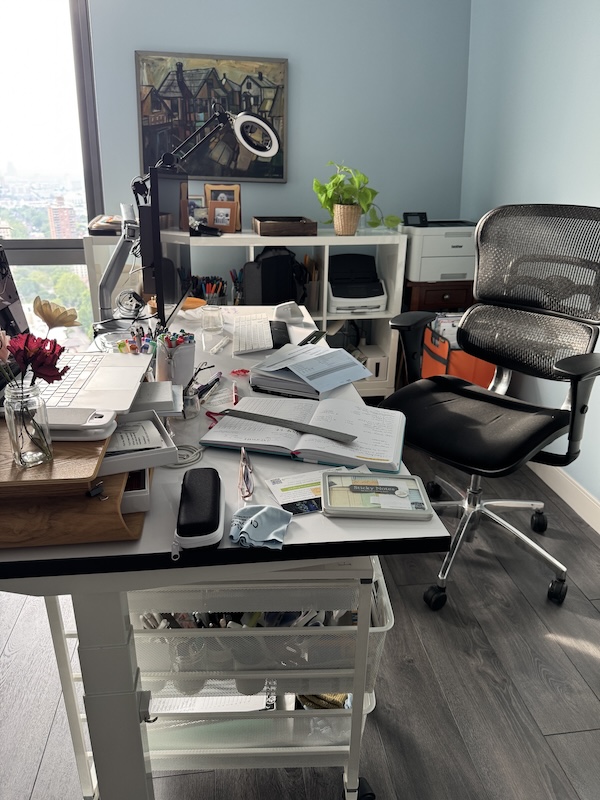
Some days I’ll just push the stuff aside and get busy dealing with my YNAB spending plan or with email. But that day. I decided to see how long it would take me to clear the desktop off. I set the stopwatch on my phone and started tidying.
In only 2 minutes and 45 seconds my desktop looked like this:

Less than three minutes to a clear desktop that made me eager to get to work. It was fantastic.
You know what would have been even better? If I had cleared my desk off the night before so I walk into an office with a clean desk. That clean desk really helps me feel motivated to get some stuff done.
At the day’s end, I almost walked away with the day’s stuff all over my desk. But knowing that it would probably take less than three minutes to clear it off, I decided to do it right then. (It took less than two minutes.)
Over the years I’ve blogged about this many times. Taking a few minutes at the end of the work day to clear off your desk reaps huge benefits to your productivity. When there is just one day’s worth of stuff to put away (assuming you have a place to put it away) clearing your desk takes very little time. And that is time well spent!
The joy of packing light

I travel probably six to ten times a year and it’s been more than a decade since I’ve used a suitcase larger than a carry-on. But I always check that carry-on because I haven’t felt tall or strong enough to lift my suitcase into the overhead bin.
Southwest was my airline of choice: it didn’t charge to check a bag and I loved its open-seating policy. But, as you may know, that ended yesterday. I’m not keen on paying to check a bag, so I’m going to be carrying mine on.
I had set a goal with my trainer of being able to easily hoist my bag into the overhead bin, but I decided to take a shortcut to sidestep the issue. I bought an even smaller suitcase, the Bagsmart Under-Seat Carry-On. I paid only about $65 for it and I’ve been very pleased with it.
I’ve taken three trips since buying the bag in March. One involved airplane and train. One was a round-trip Southwest flight and I recently flew to Charlottesville on a pair of Delta flights that were on smaller planes.
This little suitcase was a champ! On the three Southwest flights I took, I was able to place both the suitcase and my purse under the seat in front of me. (I had to sit in a window seat, though; the space under the aisle seat is smaller.) On the Delta flights the bag wouldn’t fit under the seat, but the overhead compartments were so small that all normal-sized carry-on bags had to be gate checked. And the bins were low enough in this small plane (and my suitcase light enough) that I had no difficulty putting my suitcase in the overhead compartment.
I was able to breeze past people who were waiting for their gate-checked bags in the jet bridge. In addition, it was so nice to not have to take time to check my bag (on either end of a flight). I’m a carry-on convert!
The latter two of my trips were four days and three nights. I had plenty of room in my 18” × 13.5” × 8” suitcase for what I packed, which was two dresses, a pair of shoes and a pair of slippers, pajamas and, of course, toiletries. I also took a charging station for my devices and a few extra cords. I packed my laptop, Bullet Journal and pens, in the outer pockets of this little workhorse of a suitcase. (I brought an iPad rather than my laptop on my most recent trip which made my suitcase even lighter.)
The key to my ability to pack light was wearing a lot of layers on travel days, including a warm cardigan that I could pair with any of the items in my suitcase. I’m always cold on a plane, so many layers works well for me. I wear merino wool exclusively and don’t require much variety. (I once wore the same dress for 100 days in a row.)
I find that making the decisions about what to each day before I go on a trip is easier than having a large selection from which to choose while I’m on a trip. I know not everyone is wired like me, but the benefits to traveling light make it worth a try!
Worth repeating (once again): Self-care
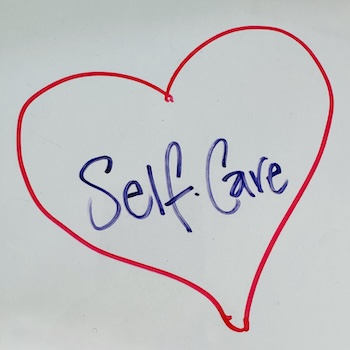
I’m passionate about asking people to be kind to themselves and not let guilt and worry about clutter (or anything else) get in the way of living their lives. Seventeen years ago, I wrote this post, called Self-Care. Thousands of posts later, it remains one of my very favorite posts. I thought I’d share it again today.
I’m always struck how clutter gets in the way of life. I have many clients who constantly feel an obligation to deal with their clutter. They plan to devote a weekend to decluttering, then they start to feel overwhelmed, so they don’t actually deal with it. (Until they call me.)
So for weeks, months, even years, they decline invitations to do fun stuff on their off hours because they should stay home and “get organized.” They don’t treat themselves to a movie, a vacation, or a bike ride because they feel an obligation to stay home and tackle what’s become for them a giant burden.
It breaks my heart.
I’m a big believer in self-care. Maybe because I don’t have kids and therefore have more free time than many women, I have no qualms about taking time away from the “shoulds” and enjoying myself. It happens that I’m easy to amuse—I’m thrilled to sit in front of a DVD of a favorite TV series and knit. That’s my idea of a great time. And I consider that self-care.
Last Sunday I spent the afternoon with some great women, chatting, laughing and doing crafts. Does my bathroom closet need sorting and purging? Oh yeah. It’ll get done some day. But I don’t let it get in the way of the very important hours in the day where I relax and enjoy myself. Getting together with my “craft sisters” nurtures me. And that’s really important.
If you’re reading organizing blogs because you’re feeling disorganized or frustrated by clutter, please don’t let it take over your life. If necessary, seek help (you can find a great organizer via NAPO’s website), and set aside time to work on your organizing project. The key is to actually do the work, rather than intending to do the work and being paralyzed in the process.
And then, please, find time to take care of yourself, rejuvenate your spirits and do something fun. Your idea of fun might be climb a mountain, like my amazing friend Shannon Wilkinson or it might be to take a bubble bath. Maybe you can make a list of things you’d love to do if you only finished getting organized. Then use the items on your list for rewards for the progress you make.
Don’t let clutter get in the way of life. Chip away at it, 15 minutes at a time. Then focus on some self-care. You’re worth it!
Links
- Getting to Good Enough podcast
- Ravelry
- NAPO St. Louis
- Organize Your Family History
- Shannon Wilkinson, life coach
- National Association of Productivity and Organizing Professionals
- Institute for Challenging Disorganization
- Are you interested in becoming a professional organizer?
- Peace of Mind Spending
